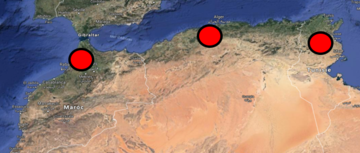Case-study sites
This project will consider three contrasted, intensively irrigated, agricultural zones in North Africa, all characteristic of a Mediterranean agriculture facing both increasing demands to produce more with less resources and national incentives to preserve the environment.
Case-study sites are the Saïs plain in Morocco, the Haut-Chéliff plain in Algeria, and the Kairouan plain in Tunisia. The plains share both similar biophysical (comparable agricultural areas, semi-arid climate characterized by variability rainfall, presence of exploited groundwater resources, poor agricultural land, requiring substantial organic and chemical amendments) and socio-economic characteristics (mosaic of mostly small and average farms (<10 ha) and a high demand for agricultural products). Yet, contrasted agrarian histories and political actions, have led to a post-collectivist, a capitalist market-integrated, and finally to State-administered situations in the different countries. We therefore hypothesize that a diversity of farming strategies, yet adapted to the same biophysical characteristics may have emerged, within which innovative solutions can be identified and improved.

